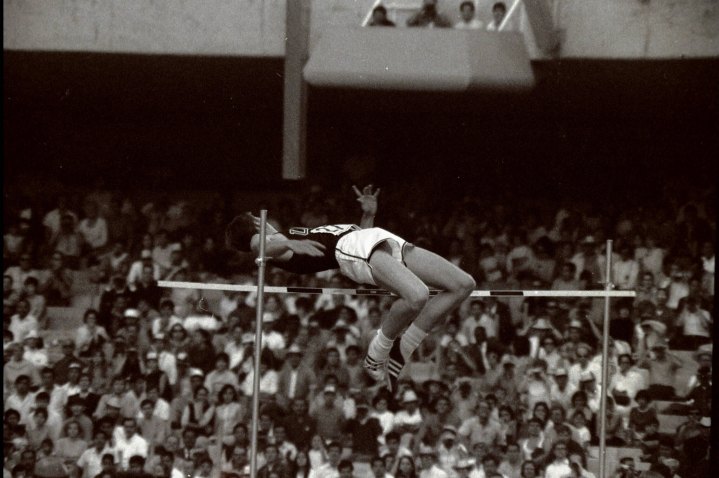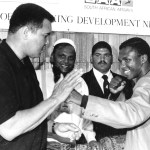TRIBUTE
Pioneering high jumper and inventor of the Fosbury Flop dies

Revolutionary high jumper Dick Fosbury died at the age of 76 on 12 March from complications from lymphoma.
Few sports people have a move named after them, or have that move linked to other forms of human achievement, but Dick Fosbury was one of those rare people.
He won the 1968 Olympic high jump gold medal with a record leap of 2.24m, using a technique he developed and which has become the only style high jumpers now employ. But in 1968, it was revolutionary.
If you have a passing interest in sport, even if you don’t know his name, you’ll be familiar with the method today’s high jumpers use to clear the bar.
After their approaching run, they launch off the foot furthest from the bar, twisting as they take off, so their backs are facing the ground and their heads, then shoulders, back, buttocks and legs clear the bar. It’s a common sight from school fields to world arenas today.

American high jumper Dick Fosbury. (Photo: Tony Duffy / Allsport)
But a little more than 50 years ago, it was unheard of. Fosbury changed the discipline of high jump and allowed athletes to go higher than would’ve been possible with the traditional “scissors” method.
It’s called the Fosbury Flop, named after Dick Fosbury.
New approach
Until the mid-1960s high jumpers basically approached the bar, launched themselves in a sitting position and tried to clear each leg in a type of scissors or straddle movement. It had its limitations.
Fosbury, who was a student at Oregon State University, wasn’t a particularly gifted athlete. He was studying civil engineering and enjoyed athletics, but had no real ambition to make it to the Olympics.
Read more in Daily Maverick: “Gordon Baker — former eight-time Comrades gold medallist, passes away”
After an unsuccessful high school sporting career, he remained enthusiastic about the high jump, but just not very good using the traditional methods of the time.
So, Fosbury decided to approach the high jump differently, launching himself backwards, off the foot furthest from the bar. It left coaches confused, while Fosbury himself said that the move simply “came naturally” to him.
This style also coincided with the introduction of foam matting for athletes to land on. Before that change in the 1960s, athletes landed in sand or sawdust, which was fine if you came down feet first, but not ideal if you were to land flat on your back, as Fosbury did.
Fosbury honed his technique at university and although it was unusual, there was nothing in the rule books to say it was illegal. So, he continued to use it with great success.
His interest in mathematics and engineering also played a part in the development of his technique. He applied science and found that when arching his back, the athlete’s centre of gravity could stay below the bar.
“If they (jumpers) get into that perfect arch, it’s a mechanical advantage to that technique,” Fosbury told the Olympic Channel.
Olympic breakout
Although US officials and competitors had seen Fosbury’s method, it was unknown to the wider world until he arrived in Mexico City for the Games as a gangly, awkward 21-year-old.
He went through the preliminary rounds without knocking the bar off. In the final, he and compatriot Ed Caruthers, who, like all the other high jumpers in the contest, employed the scissors method, battled for gold.
Caruthers, a superb athlete, cleared 2.22m along with Fosbury while the Soviet Union’s Valentin Gavrilov dropped out at 2.20m.
Read more in Daily Maverick: “A daughter’s tribute to the ‘voice of cricket’ Robin Jackman”
When the bar was raised to 2.24m, an Olympic record height at the time, Fosbury was the only athlete to go clear, to the delight of the crowd.
He had started the Olympics as something of a novelty show and ended it as one of the most popular athletes at an Olympics that saw so many records broken in track and field.

Dick Fosbury, inventor of the ‘Fosbury Flop’, on his way to a gold medal at the 1968 Olympics in Mexico. (Photo: Tony Duffy / Allsport)
Fosbury’s jumping style was only one part of his appeal though. He was only the first high-profile athlete to visibly display his techniques to enter the right mental state before jumping.
Read more in Daily Maverick: “Rugby world pays tribute to ‘brilliant man’ Joost van der Westhuizen”
He could spend upwards of two minutes talking to himself, psyching himself up for the jump. Before then, athletes went to their mark and charged off towards the target within seconds. Fosbury showed the value of entering the right mental state before attempting a jump.
Visit Daily Maverick’s home page for more news, analysis and investigations
His 1968 win was also remarkable when you consider his physical condition in the final.
“I have a bad back,” Fosbury told the New York Times after his Mexico victory. “I lost a big patch of skin on the back of my left heel. Then I tripped on some stone steps the other day and strained a ligament in my right foot. I guess I use positive thinking. Every time I approach the bar I keep telling myself, ‘I can do it, I can do it’.”
Tributes pour in
Although Fosbury’s athletics career was short – he opted to finish his degree and opened a civil engineering business in Idaho after he completed his studies in 1972. There he met and married Robin Tomasi.
He never competed in the Olympics again but did become a renowned high jump teacher and served as vice-president of the US Olympic and Paralympic Association.
See Fosbury winning the 1968 Olympic High Jump gold here.
“It is with a heavy heart that I must announce that long-time friend and client Dick Fosbury passed away peacefully in his sleep early Sunday morning after a brief recurrence of lymphoma,” his agent Ray Schulte wrote on Instagram.
“The track and field legend is survived by his wife Robin Tomasi, son Erich Fosbury and stepdaughters Stephanie Thomas-Phipps… and Kristin Thompson.”
Officials from the world of athletics and the Olympics also paid tribute to Fosbury.
“With his groundbreaking ‘Fosbury Flop’ technique, Dick Fosbury not only won Olympic gold at Mexico City 1968 but also revolutionised the high jump. He was truly an Olympic pioneer and legend,” Team USA posted on Twitter.

Dick Fosbury speaks at US Olympic & Paralympic Hall of Fame Class of 2019 induction ceremony in Colorado Springs on 1 November 2019. (Photo: Jamie Schwaberow / Getty Images for USOPC)
“I am deeply saddened by the passing of Dick Fosbury, a true legend and pioneer in the world of track and field. Dick’s innovative technique of the ‘Fosbury Flop’ revolutionised the high jump event and forever changed the sport,” said Max Siegel, CEO of USA Track & Field.
And International Olympic Committee president Thomas Bach added: “Dick Fosbury was always true to the Olympic values and served the Olympic Movement in a number of functions, including as President of World Olympians. He will forever be remembered as an outstanding Olympic Champion.”
The last word should go to Fosbury himself. In that 1968 New York Times interview, after winning gold, he said: “I think quite a few kids will begin trying it my way now. I don’t guarantee results, and I don’t recommend my style to anyone. All I say is if a kid can’t straddle, he can try it my way.” DM


















 Become an Insider
Become an Insider
Comments - Please login in order to comment.